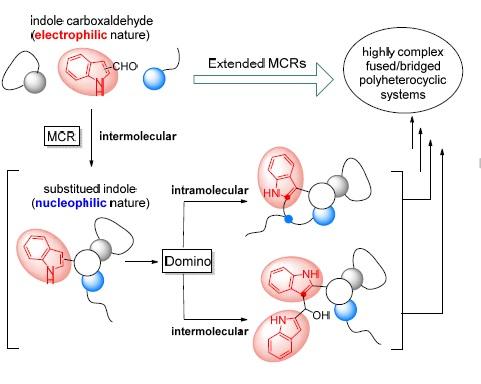An innovative protocol eases the synthesis of high structural complex molecules

Credit: Angewandte Chemie International Edition
The synthesis of complex molecules such as drugs, requires a process that sometimes involves several phases that increase its cost and harden the access to the product. Now, a team of the University of Barcelona has designed a new methodological approach that combines multicomponent reactions with domino type processes -continuous transformations on an only compound- to ease the synthesis of high structural complex molecules.
he study, published in the journal Angewandte Chemie International Edition, is led by Professor Rodolfo Lavilla, from the Faculty of Pharmacy and Food Sciences and the Institute of Biomedicine (IBUB) of the University of Barcelona. The study, whose first signatories are researchers Ouldouz Ghasghaei and Marina Pedrola (UB-IBUB), counts on the participation of experts from Masaryk University (Czech Republic) and the Leibniz Research Institute for Environmental Medicine (Germany).
Multicomponent reactions: more simplicity and efficiency
Multicomponent reactions are protocols that ease the chemical synthesis of new high complexity and structural diversity compounds. These reactions can form several bonds and generate new molecules with a minimum amount of three reactives. These processes are very direct and help obtain molecules in a quick and efficient way (simplicity, atom economy, etc.) compared to traditional processes. Also, these are also the most sustainable synthetic pathways from an environmental perspective (saving resources, less waste, etc.).
In the study, the experts create a main principle by which the polarity change of a reactive in a multicomponent process unchains domino reactions that enable the access to a complex connectivity. This principle would explain many transformations and would ease the design of new processes in the field of synthetic chemistry.
According to Lavilla, the new principle has been developed “with indole nuclei, a heterocycle present in many natural molecules, and particularly in drugs. Also, the compounds that were prepared with this methodology present a high structural variability (linear and angular fused rings, rigid or flexible compounds, etc.)”. In the biological field, most of the products the researchers synthetized “present a powerful activity as ligands of the aryl hydrocarbon receptor”, he adds, “a molecule with a determining role in several biological processes that is regarded as a potential pharmacological target for the development of new drugs”.
So far, only a few specific cases of multicomponent reactions associated with a domino process had been described. “Both domino and multicomponent reactions are very complex at a mechanistic scale. There are many bonds, and many elemental phases, reaction intermediates, and so on”, notes the researcher. He adds that by merging these two reaction families into an only process “we increase the synthetic complexity extraordinarily. Therefore, we consider the description of these processes to be an advance to generalize them and expand them into combinations in synthetic chemistry”.
Technology for a greener chemistry
Multicomponent reactions eased the development of new molecules of pharmaceutical and biomedical interest (biological probes, fluophores, complex molecules). These techniques are getting more exploited by other industrial sectors every day.
“However, there are very few general multicomponent reactions -about a dozen compared to the hundreds of biomolecular reactions-, and this limits its applicability. In this sense, a great scientific activity is being carried out in this field to ease the access to this type of general connectivity through these reactions, and enable its application to the development of all types of organic compounds at a large scale (drugs, plastics, fertilizers, etc.)”, concludes the researcher.
###
Media Contact
Rosa Martínez
[email protected]
Original Source
https:/
Related Journal Article
http://dx.




